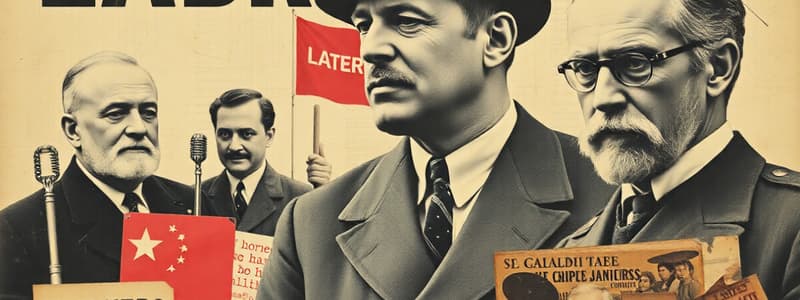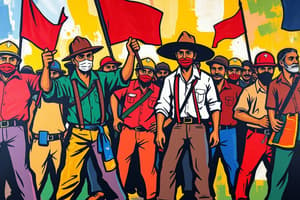Podcast
Questions and Answers
What was one of the primary goals of early labor unions in the 19th century?
What was one of the primary goals of early labor unions in the 19th century?
- To improve wages and working conditions (correct)
- To promote technological advancements in industries
- To limit immigration to protect jobs
- To increase worker participation in government
Which historical figure was a founding member of the American Federation of Labor (AFL)?
Which historical figure was a founding member of the American Federation of Labor (AFL)?
- John L. Lewis
- Terence V. Powderly
- Samuel Gompers (correct)
- Eugene V. Debs
What event marked a nationwide protest against wage cuts that resulted in violent clashes in 1877?
What event marked a nationwide protest against wage cuts that resulted in violent clashes in 1877?
- The Great Railroad Strike (correct)
- Haymarket Affair
- Pullman Strike
- Ludlow Massacre
Which legislation was influenced by increased awareness of labor issues after 1938?
Which legislation was influenced by increased awareness of labor issues after 1938?
How did labor unions contribute to the growth of the middle class?
How did labor unions contribute to the growth of the middle class?
What was the outcome of the Haymarket Affair in 1886?
What was the outcome of the Haymarket Affair in 1886?
Which of the following was a campaign by labor unions addressing significant social issues in the late 19th century?
Which of the following was a campaign by labor unions addressing significant social issues in the late 19th century?
What consequence did strikes and labor disputes commonly have on industries?
What consequence did strikes and labor disputes commonly have on industries?
Flashcards are hidden until you start studying
Study Notes
Formation Of Labor Unions
- Early Beginnings: Labor unions began forming in the early 19th century as workers organized to improve wages and working conditions.
- Trade Unions: Focused on specific trades, these groups sought to secure better terms for skilled workers.
- Legal Challenges: Many unions faced legal restrictions and could be considered illegal conspiracies.
- First National Unions: Organizations such as the National Trades' Union formed in 1834, representing multiple trades.
Key Historical Figures
- Samuel Gompers: Founding member of the American Federation of Labor (AFL) in 1886; advocated for practical goals like higher wages and shorter workdays.
- Terence V. Powderly: Leader of the Knights of Labor, promoting inclusivity among all workers, regardless of skill.
- Eugene V. Debs: Founder of the American Railway Union; known for his commitment to socialism and labor rights.
Major Strikes And Conflicts
- The Great Railroad Strike of 1877: Nationwide strike protesting wage cuts, leading to violent clashes.
- Haymarket Affair (1886): Labor rally in Chicago that turned violent; resulted in backlash against unions and increased scrutiny.
- Pullman Strike (1894): Involved railroad worker protests and drew nationwide attention, leading to federal intervention.
Impact On Labor Laws
- Legislative Changes: Increased awareness of labor issues led to laws like the Fair Labor Standards Act post-1938.
- Union Recognition: The existence of powerful unions pushed for the recognition of collective bargaining rights.
- Child Labor Laws: Unions campaigned against child labor, resulting in stricter regulations by the late 19th century.
Social And Economic Consequences
- Rise of the Middle Class: Labor movements contributed to the growth of a middle class with better wages and working conditions.
- Worker Solidarity: Unions fostered a sense of collective identity among workers, leading to greater solidarity.
- Economic Strain: Strikes and labor disputes often disrupted industries, creating tension between workers and employers.
- Social Change: Labor unions played a significant role in pushing for social reforms, including improvements in public health and education.
Formation of Labor Unions
- Labor unions emerged in the early 19th century as workers sought to improve wages and working conditions.
- Early unions often focused on specific trades, aiming to secure better terms for skilled workers.
- Many unions faced legal obstacles, being considered illegal conspiracies in some cases.
- The National Trades’ Union, formed in 1834, became one of the first national unions, representing various trades.
Key Historical Figures
- Samuel Gompers was a key figure in the labor movement, founding the American Federation of Labor (AFL) in 1886.
- Gompers advocated for practical goals like higher wages and shorter workdays.
- Terence V. Powderly, leader of the Knights of Labor, promoted inclusivity, advocating for the rights of all workers regardless of skill.
- Eugene V. Debs was a prominent socialist and labor rights advocate, founding the American Railway Union.
Major Strikes and Conflicts
- The Great Railroad Strike of 1877 was a nationwide strike protesting wage cuts, leading to violent clashes with authorities.
- The Haymarket Affair of 1886, a labor rally in Chicago, turned violent, causing a backlash against unions and increased scrutiny.
- The Pullman Strike of 1894 involved railroad worker protests and drew national attention, ultimately leading to federal intervention.
Impact on Labor Laws
- The rise of labor unions led to legislative changes, including the Fair Labor Standards Act in 1938, which aimed to improve working conditions.
- The presence of powerful unions helped secure recognition of collective bargaining rights.
- Unions campaigned against child labor, contributing to stricter regulations by the end of the 19th century.
Social and Economic Consequences
- Labor movements contributed to the growth of a middle class with better wages and working conditions.
- Unions fostered a sense of collective identity among workers, strengthening solidarity.
- Strikes and labor disputes often disrupted industries, creating tension between workers and employers.
- Labor unions played a significant role in pushing for social reforms, including improvements in public health and education.
Studying That Suits You
Use AI to generate personalized quizzes and flashcards to suit your learning preferences.




